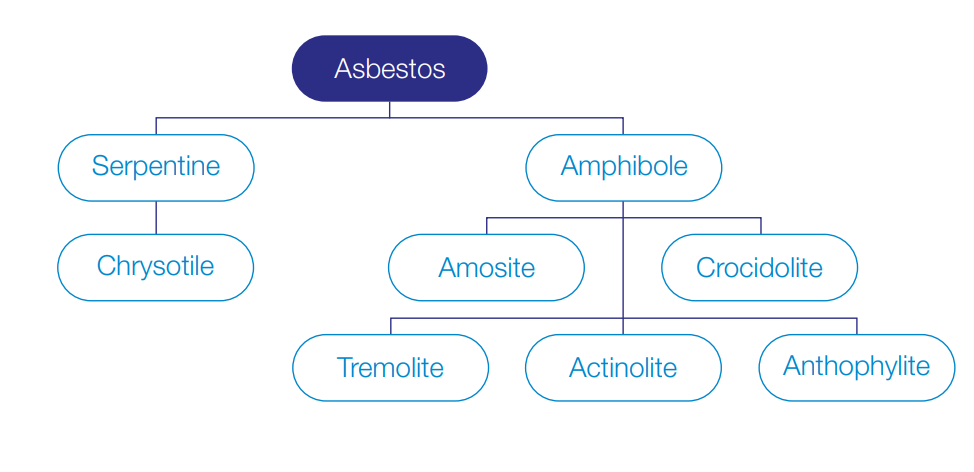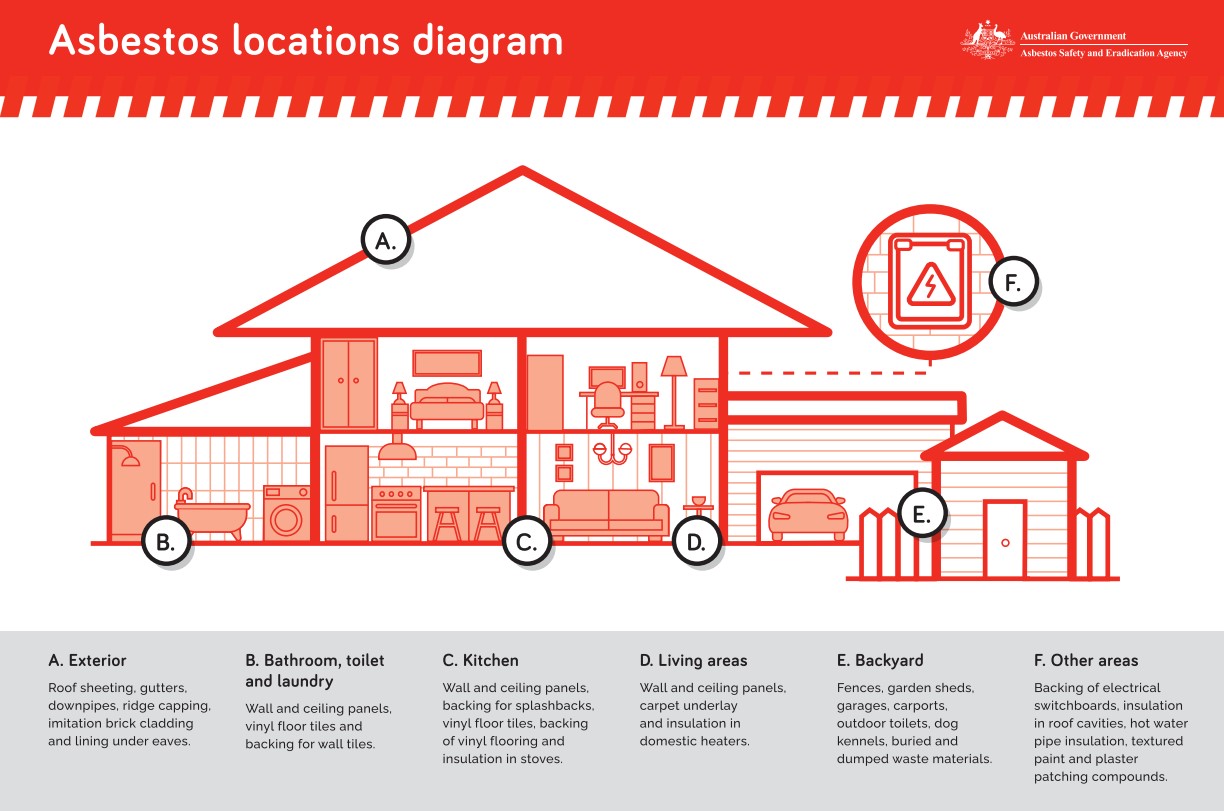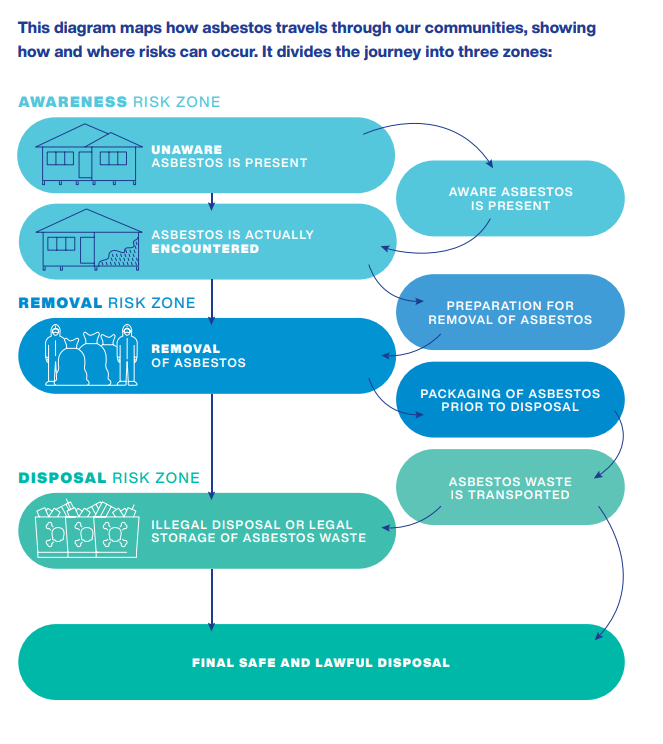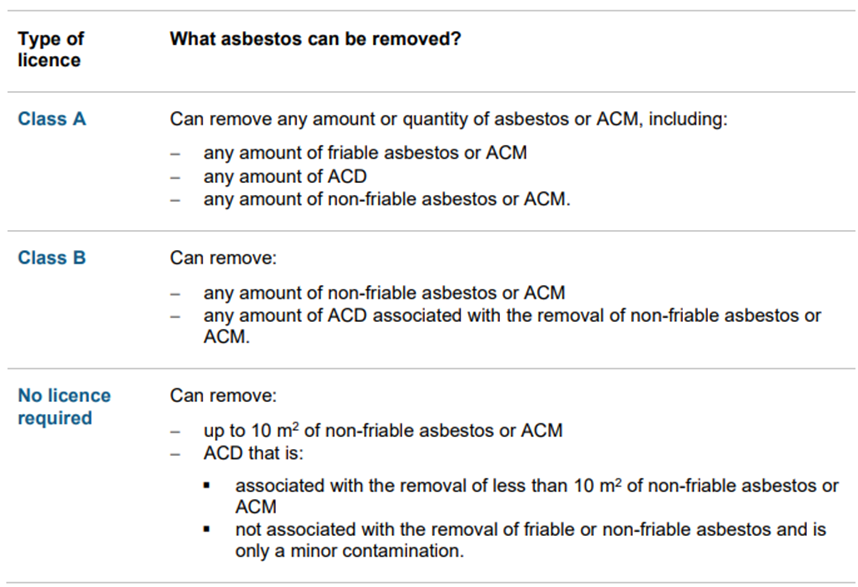Australian councils have a responsibility in relation to educating the community about asbestos safety. Part of this responsibility is to provide clear, consistent and up-to-date information – this is where this template can help.
HOW TO USE THE ASBESTOS LANDING PAGE TEMPLATE
Asbestos landing page template
Asbestos is a group of six types of naturally occurring, rock forming silicate minerals made up of thin, microscopic fibres or a mixture that contains one or more of these minerals.

- Asbestos-containing material (ACM) is any material or thing that, as part of its design, contains asbestos; there are friable and non-friable (or bonded) asbestos-containing materials.
- Friable asbestos is material that is in a powder form or that can be crumbled, pulverised or reduced to a powder by hand pressure when dry and contains asbestos.
- Non-friable (bonded) asbestos is material containing asbestos that is not friable asbestos, including material containing asbestos fibres reinforced with a bonding compound, such as cement.
- During the 1980s, asbestos materials started to be phased out in favour of materials made with no asbestos.
- All asbestos mining in Australia was stopped by 1983.
- Asbestos was completely banned in Australia from 31 December 2003.
- From 31 December 2003, the total ban on manufacture, use, reuse, import, transport, storage or sale of all forms of asbestos came into force.
- Friable asbestos products were used in residential, commercial and industrial settings beginning in the late 1800s.
- Asbestos cement (non-friable or bonded asbestos) materials were first imported to Australia around 1903 and were first manufactured here from around 1917 onwards.
- Many homes built before 1990 contain asbestos.
- Asbestos can be anywhere inside or outside the home. (see diagram below)
- Across Australia, it is estimated that asbestos is in 1 in 3 homes.
- If a home was built before 1990 and hasn’t had a major renovation it is likely to contain asbestos.

- Asbestos was used in over 3,000 products.
- Asbestos products in Australian buildings are anywhere between 30–100 years old.
- This age means that asbestos products have reached end of product life and are degrading, increasing the risk of exposure to asbestos fibres.
- It is estimated that 13 million tonnes of asbestos-containing materials were consumed in the Australian built environment.
- It is estimated that more than 6 million tonnes of Australia’s asbestos legacy remains in the built environment.
- Asbestos cement products make up around 95% of the remaining legacy asbestos in the built environment.
- Link to ASSEA ‘Asbestos Product Guide’ website
- The World Health Organisation (WHO) says there is no known safe level of exposure to asbestos.
- No threshold has been identified below which cancer will not occur.
- The risk of developing an asbestos-related disease increases with more exposures.
- The risk of developing an asbestos-related disease increases in proportion to the number of asbestos fibres a person breathes in during their life.
- Some people develop disease from minor exposure, and it is not possible to determine who will or will not get disease.
- The only way to eliminate the risk is to avoid exposure.
- If you feel you may have been exposed to asbestos fibres at any time in your life please consider recording this information on the National Asbestos Exposure Register.
- Asbestos causes cancer.
- Asbestos also causes several life-threatening diseases.
- Exposure to asbestos fibres can cause asbestosis, mesothelioma, and cancer of the lung, ovary, and larynx.
- An estimated 4,000 Australians die annually from asbestos-related diseases. This is more than three times the annual road toll.
- A proportion of lung cancer deaths in Australia are attributable to past asbestos exposure.
- Approximately 700 people die annually from the aggressive cancer mesothelioma which is caused mainly by exposure to asbestos.
- There is no cure for mesothelioma.
- Mesothelioma has a long latency period with symptoms typically appearing decades after a person has been exposed to asbestos.
- The latency period can range from 20–60 years.
- Link to Asbestos support and advocacy groups
- The workplace exposure standard for asbestos in Australia is 0.1 fibre per millilitre of air over an 8-hour period.
- Employers must ensure worker exposure to airborne asbestos is eliminated. If it cannot be eliminated, it must be minimised as far as possible and the exposure standard for asbestos must not be exceeded.
- All asbestos-containing materials are dangerous if damaged, disturbed or deteriorating.
- Under Work Health and Safety laws, an up-to-date asbestos register and management plan must be kept for all workplaces where asbestos is present or assumed to be present, unless that workplace is exempt because it is a domestic premise used for residential purposes.
- All exposure to airborne asbestos fibres which can arise from asbestos-containing materials that are damaged, disturbed or deteriorating must be avoided.
- The highest risk of exposure today is in the home/residential environment.
- In 2020, it was estimated that 1 in every 3 new mesothelioma cases was from non-occupational exposure.
- In Australia there is an increasing number of cases of mesothelioma diagnosed that have an associated non-occupational exposure.
- Even if asbestos exposures were to cease completely, deaths from asbestos-related cancers would be expected to continue for the next four to five decades due to the latency period.
- See also 'Asbestos – how to report a safety concern’
- Work health and safety laws have specific requirements to prevent asbestos exposure in all workplaces.
- Under environment protection laws, everyone has a duty not to pollute the environment or to unlawfully dispose of asbestos waste.
- Everyone also has a duty under common law and public health laws to take reasonable care not to cause harm to another person. This includes preventing the release of airborne asbestos fibres.
- People selling homes that contain asbestos may be legally obliged to tell potential buyers. Requirements differ in each state, so seek advice from real estate agents or property conveyancers.
- (ACTION: Tailor this paragraph to reference the property disclosure laws applicable to your state/territory - Disclosure of asbestos in residential property)

- You cannot see airborne asbestos fibres because they are invisible to the naked eye.
- You cannot tell if a material contains asbestos just by looking at it - only scientific testing of a sample can confirm the presence of asbestos.
- Professionals who can assist with identifying asbestos include:
— occupational hygienists who have experience with asbestos
— licensed asbestos assessors and removalists
— individuals who have undertaken an accredited training course in asbestos identification.
An asbestos assessment (i.e. asbestos survey, asbestos audit, or asbestos inspection) can provide information to prevent exposure to asbestos fibres and reduce unexpected future costs when undertaking repairs or renovations.
An asbestos assessment usually begins with the assessor gathering background information, for example, information about the age of the property and details about its construction. The assessor then conducts a physical audit or visual inspection of the property, including internal and external areas that are accessible. Samples of suspect asbestos-containing materials may be taken for laboratory analysis.
(ACTION: Place here a link to your state/territory government Safe Work or Asbestos website for a list of licenced asbestos assessors) - see table below
| Asbestos ACT | Asbestos - WorkSafe ACT |
| Asbestos NSW | Asbestos in NSW | Asbestos |
| Asbestos in the NT | Home - Asbestos (nt.gov.au) |
| Queensland Government - Asbestos | Homepage | Asbestos |
| South Australian Government - Asbestos | Asbestos.sa.gov.au | Asbestos.sa.gov.au |
| WorkSafe Tasmania | Asbestos safety (worksafe.tas.gov.au) |
| Asbestos in Victoria | Asbestos in Victoria | asbestos.vic.gov.au |
| Western Australian Government - Working with Asbestos | Working with asbestos - WorkSafe – DEMIRS |
For more details:
Asbestos in the home
Asbestos in the workplace
It is strongly recommended that householders do not remove any amount of ACM and that they engage the services of licenced professionals to undertake the work.
(ACTION: Place here a link to your state/territory government Safe Work or Asbestos website for a list of licenced asbestos removalists)
WHS regulations state that a person conducting a business or undertaking who commissions the removal of asbestos at the workplace must ensure asbestos removal work is carried out only by a licensed asbestos removalist who is appropriately licensed to carry out the work, unless specified in the WHS Regulations that a licence is not required.
There are two types of licences: Class A and Class B. The type of licence required will depend on the type and quantity of asbestos or ACM that is being removed at a workplace.

Source: model_code_of_practice_how_to_safely_remove_asbestos.pdf (safeworkaustralia.gov.au)
Note: ACD is asbestos-containing dust or debris
(ACTION: Place here a link to your state/territory government Safe Work or Asbestos website for the relevant removal restrictions applicable – see table above in Asbestos Assessment)
The transport of commercial asbestos waste is covered under EPA legislation. Most states and territories require tracking of asbestos waste above a certain threshold. Disposal sites are regulated by the EPA and local government regulations.
All jurisdictions, track and require an environmental authorisation to transport asbestos waste interstate in accordance with the National Environmental Protection (Movement of Controlled Waste between States and Territories) Measure.
General requirements for transporting asbestos waste include:
- Asbestos-contaminated waste must be wetted down
- All asbestos waste must be transported in a part of the vehicle that is covered and leak-proof
(ACTION: Place here a link to your state/territory government EPA website for the relevant tracking mechanism applicable and to Safe Work website for list of licenced asbestos transporters)
Asbestos waste must be disposed of in accordance with the relevant state or territory Environment Protection Authority (EPA) requirements. Asbestos waste can only be disposed of at a site licensed by the EPA and it must never be disposed of in the general waste system. Under WHS laws, asbestos waste must be disposed of as soon as practicable at a site authorised to accept asbestos waste. Under environmental laws, disposal facilities require an environment licence to accept asbestos waste. Criminal penalties apply for contravention of these laws.
(ACTION: Provide asbestos disposal information specific for your council’s residents OR review the information on ASSEA’s asbestos waste facilities search tool for accuracy, inform us of any updates required, and reference directly to it: Search for disposal facilities.
If providing your own details, consider including the following information of any facilities within your local government area that are licenced to accept asbestos-containing material:
- The location address, including a Google map, with any particular details of note to assist navigation.
- The days and hours of operation, including specific asbestos acceptance times. You should also advise of days when the facility is closed e.g Public Holidays, Fire Hazard days.
- The conditions of asbestos acceptance, such as residential requirements, transport and packaging requirements, prior notification (including any forms required to be completed, or tracking systems to be complied with for commercial operators), and handling requirements at the facility.
- The quantity limits, if such exist, in either weight (tonnes), volume (cubic metres), or other, such as trailer load or truck load.
- The cost of disposal per tonne, cubic metre or trailer/truck load, including minimum fees.)
Illegally disposed asbestos is a risk to public health and the environment. Councils play an important role in responding to illegally disposed asbestos by:
- Reacting quickly to information received
- Assessing and removing asbestos risks (‘makesafe’ work to prevent further damage)
- Implementing suitable safety controls, such as traffic management
- Cleaning up the affected area
- Communicating with the public
- Conducting air monitoring
- Undertaking clearance inspections
- Conducting investigations to uncover perpetrators.
(ACTION: Provide information on how your council specifically responds to illegal disposal of asbestos incidents, including how the public can report information e.g. RID Online Public. Most councils provide a phone number and/or an online form for members of the public to provide specific information that can assist councils to respond quickly and effectively to the incident, and conduct follow-up investigations.)
(ACTION: Provide information on how members of the public can contact council to report asbestos safety concerns (other than illegal dumping) in their local area, such as unauthorised asbestos removal being conducted by neighbours.)
(ACTION: Place a link to the dedicated government asbestos website in your state or territory - see table above in ‘Asbestos assessment’ section
Advise residents that these sites are effectively ‘one-stop shops’ for asbestos-related information specific to each jurisdiction.
There is really no need to add any other links as these sites are comprehensive and cover all aspects. This will ensure that people will not be overwhelmed by information or frustrated in their search for information about asbestos.)


